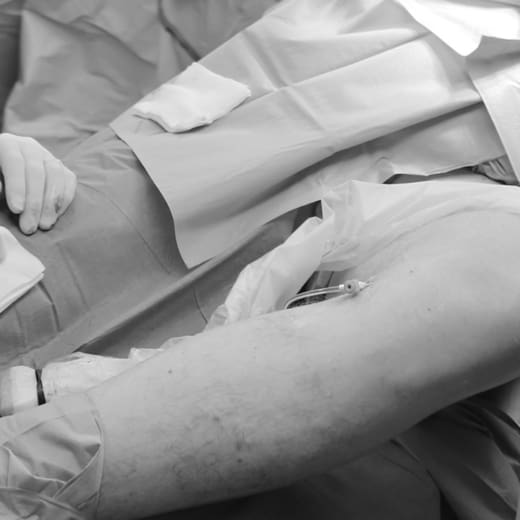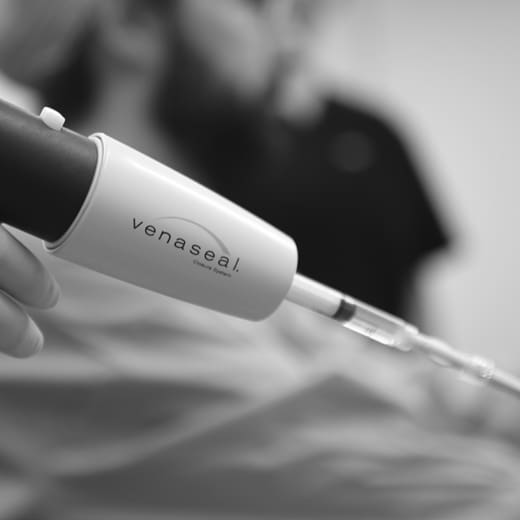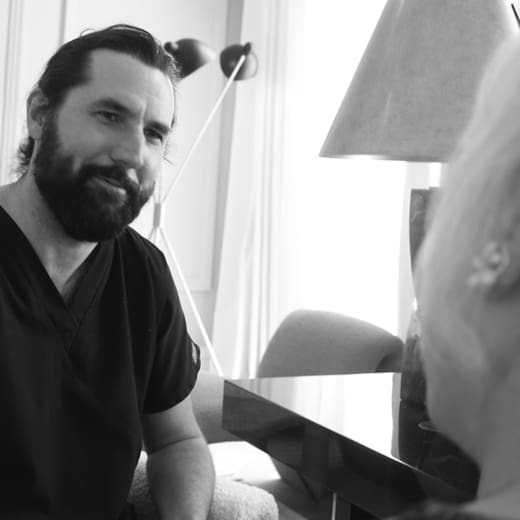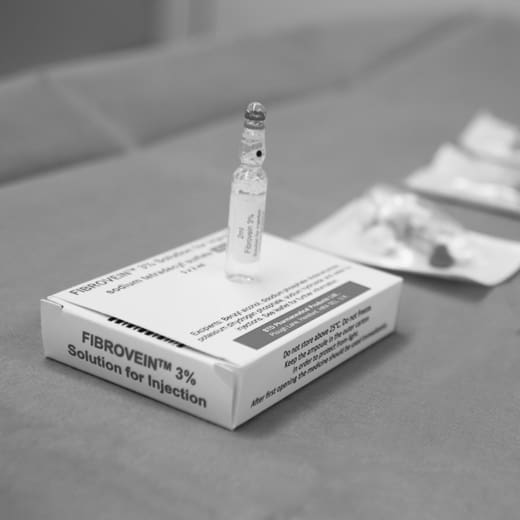McKeown Medical
167 Bath Street, Glasgow, G2 4SQ
Varicose veins are enlarged, twisted veins that often appear just under the skin, primarily in the legs and feet.
Date posted — 7.10.24
Varicose veins are enlarged, twisted veins that often appear just under the skin, primarily in the legs and feet. They can be blue, purple, or flesh-coloured and are often raised, giving a bumpy or rope-like appearance on the skin’s surface. These veins develop when the valves in the veins that regulate blood flow become weakened or damaged, causing blood to pool and the veins to enlarge.
While varicose veins are generally more common in older adults, women, and those with a family history of the condition, factors such as prolonged standing, obesity, and pregnancy can increase the risk.

The symptoms of varicose veins can range from mild to severe. Some people may experience aching, heaviness, or cramping in the legs, particularly after standing or sitting for extended periods. The affected area might also feel itchy or develop a burning sensation.
In more severe cases, varicose veins can lead to swelling, throbbing, and even skin changes, such as discolouration or the development of ulcers near the ankles. The condition is not only a cosmetic concern but can also cause discomfort and, in some cases, lead to more serious circulatory problems.
The best treatment options for varicose veins depend on the severity of the condition, the symptoms experienced and the anatomy of the problematic veins. A detailed clinical review by an expert vascular surgeon, along with a detailed ultrasound scan, will delineate the optimal treatment.
For mild cases, lifestyle changes can be effective in managing symptoms. These include regular exercise to improve circulation, elevating the legs when resting, and wearing compression stockings, which help to reduce swelling and discomfort by improving blood flow in the affected veins. Weight management and avoiding prolonged periods of standing or sitting can also alleviate symptoms and prevent the condition from worsening.
For more severe cases or when lifestyle changes are insufficient, medical treatments may be necessary. Sclerotherapy is a common procedure where a solution is injected into the varicose veins, causing them to collapse and eventually fade. This is most suitable for smaller veins just below the surface of the skin.
The next level of treatment is endovenous treatment, which means operating inside the problematic veins to cause them to collapse. Traditionally, this has been done using either laser or radiofrequency energy to close the affected blood vessels down.
More recently, the VenaSeal™ procedure has been introduced. This is an even less invasive option which uses a special glue to close the veins down.
In cases where these treatments are ineffective or unsuitable, invasive surgical options like vein stripping or phlebectomy may be recommended to remove or tie off the affected veins.
Consulting with an expert vascular surgeon is essential to determine the most appropriate treatment plan based on your individual needs and the severity of your condition.
Dr Alex Vesey is our expert consultant vascular surgeon who heads up our varicose vein team. Listen to him explain your options for varicose vein treatment.

Varicose veins can theoretically happen anywhere on the body but most commonly affect the veins on the legs. Several treatments are available to target and remove varicose veins in the legs specifically.
Endovenous laser treatment (EVLT) and Radiofrequency ablation (RFA) are minimally invasive procedures that remain very popular because they avoid the need for traditional surgery. Both procedures are performed under local anaesthetic and involve inserting a thin tube inside the vein and destroying the vein by delivering heat to close the vein down. Both of these treatments offer a high success rate with less discomfort and scarring than traditional surgery.
The newer VenaSeal™ procedure causes even less discomfort by closing the vein using glue rather than heat. This allows patients an even more rapid return to normal activities without the need to wear compression stockings.
For veins that are not suitable for these treatments, sclerotherapy is a widely used option, especially for smaller varicose veins or spider veins in the legs. During sclerotherapy, a solution is injected directly into the vein, causing it to collapse and gradually be absorbed by the body. Multiple sessions may be required depending on the extent of the varicose veins.
An alternative treatment for smaller veins is a minor surgical procedure called microphlebectomy. This involves making tiny incisions under local anaesthetic to remove problematic veins. While slightly more invasive than sclerotherapy injections, microphlebectomy can be very effective because it physically removes the vessels, which means they cannot come back.
Consulting with an expert vascular surgeon is essential to choosing the most appropriate treatment based on the specific characteristics of the varicose veins in the legs.
Spider veins are small, web-like veins often associated with varicose veins. To treat these, several effective treatment options are available.
Sclerotherapy is the most common and widely used method. In this procedure, a solution is injected directly into the spider veins, causing them to collapse and fade over time. The body gradually absorbs the treated veins, leading to an improved appearance. Sclerotherapy is minimally invasive, typically requires no anaesthetic, and can be done in the outpatient clinic. Multiple sessions may be needed depending on the size and number of spider veins.
Another popular treatment for spider veins is laser therapy. This approach uses focused light energy to target and heat the affected veins, causing them to collapse and eventually disappear. Laser therapy is particularly effective for small, delicate veins that may not be suitable for sclerotherapy. The treatment is non-invasive, and while some patients may experience mild discomfort during the procedure, it generally requires no downtime. In addition to these treatments, maintaining healthy lifestyle habits, such as regular exercise, weight management, and avoiding prolonged periods of standing, can help prevent the development or worsening of spider veins.
If you’d like to find out which varicose veins treatment is the right treatment for you, the first step is to fill out our online consultation form. From there, our team will be able to arrange an initial consultation and ultrasound scan, and we can work together to create a treatment plan that is tailored to your needs.

When it comes to treating varicose veins, VenaSeal™ has emerged as a revolutionary option that offers a minimally invasive and...

Radiofrequency ablation (RFA) and endovenous laser ablation (EVLA) are two minimally invasive treatments used to effectively treat varicose veins, but...

Foam sclerotherapy is an advanced form of sclerotherapy used to treat larger varicose veins, particularly those that may not respond...
1 / 3
2 / 3
3 / 3

When it comes to treating varicose veins, VenaSeal™ has emerged as a revolutionary option that offers a minimally invasive and...

Radiofrequency ablation (RFA) and endovenous laser ablation (EVLA) are two minimally invasive treatments used to effectively treat varicose veins, but...

Foam sclerotherapy is an advanced form of sclerotherapy used to treat larger varicose veins, particularly those that may not respond...
Thank you to our incredible patient for allowing us to share these pictures with you.
This patient has been with me for years but the thing we have always struggled with has been the texture of the skin around the mouth and lower face which has had a lot of sun over the years.
We’d tried less invasive options but ultimately when the skin changes get to this level the only thing that makes a dramatic improvement is full field resurfacing.
There is literally no other treatment capable of undoing sun damage like this. The patient is only a few weeks post-op and still a bit red so she is wearing make up to hide the redness, but already obsessed by the texture of her new skin.
What do you think?
If you`d like to know if you`d benefit from this treatment send us a DM with some pictures or visit the link in our profile for more information on full laser resurfacing.

We`re going live on Wednesday at 7PM! Join Dr Rhona and Dr Iain (@driainmartin) on Instagram live, where they`ll be discussing everything about periods and heavy menstrual bleeding including:
What is “normal” when it comes to menstruation
Heavy periods - what is a heavy period and what might be causing it
Myths vs facts - getting the right information and the right treatment for period problems
They`ll also be answering your questions live, so if there`s anything you`d like to ask, leave a comment or head to our stories. We hope you can join us!

Since we are now in full swing filler season, I’m very grateful to this patient for allowing us to share her pictures to demonstrate how much lift we can achieve just using filler.
Discover more about our method at the link in our bio.

Summer is almost here! If you’re putting off wearing your favourite summer dresses and shorts because of varicose veins, now is the time to think about treatment.
Varicose veins aren’t just a cosmetic concern - they can ache and throb, as well as make us feel self-conscious, especially as the warmer weather approaches.
With so many treatments available, it can be difficult to know where to start. Here’s our lovely Dr Alex with a quick overview of how we can help reduce discomfort, improve appearance and boost your confidence in time for summer.
If you, or someone you know, have been thinking about treatment, now is a great time to explore your options with plenty of time to feel the benefits before summer - check the link in our bio for more details.

Now that spring has finally sprung we are very much in peak time for filler treatments in the clinic.
So many patients would benefit from filler, but are scared of them because of the horror stories so I wanted to share a few examples this week of what filler looks like - in the correct hands!
Here are some examples of the natural looks we achieve with the McKeown Method.
Discover more about our method at the link in our bio.

What a difference a week is! This is one of our patients just a week out from her deep plane face and neck lift by the ever so talented @bramhallplasticsurgery.
The deep plane technique is the most technically challenging facelift to perform and Russell remains the only surgeon in Scotland performing this procedure, which involves going much deeper into the face to reposition the tissues rather than just pull them tight.
The outcome is a much more effective rejuvenation, even in unflattering poses when your head is bent forward, and a result that lasts much longer than a traditional facelift.
What do you think?

Thank you so much to our wonderful patient for allowing us to share her before and after pictures. She’s around 6 weeks after full field resurfacing.
One of the great things about this treatment is that, in addition to wiping wrinkles away, it also gives some pretty impressive skin tightening too. If you look at her forehead, upper and lower eyelids you can really see how much tighter the skin is.
The stubborn forehead lines and lines through the eyebrows have gone and, of course, the lines around the mouth are significantly reduced. These will continue to improve for up to six months as the skin continues to heal. She’s still a little pink, which will fade over the next few months, but with a little tinted moisturiser you’d never know. The patient is over the moon.
What do you think?
We can now offer full laser resurfacing with sedation and you can see more about the procedure in the link in our profile.

Yesterday we announced that we’re the first clinic in Scotland to have the CoolSculpting® Elite so today I wanted to show you an example of the kind of results we can achieve with this treatment.
We’re so grateful to this patient for allowing us to share her results before and after CoolSculpting®. As you can see here, she had a stubborn area of fat around her belly which she was finding difficult to shift with diet and exercise alone.
She’s absolutely delighted with the result - what do you think?
For more information on CoolSculpting® and to get booked in to be ready for summer, check out the link in our bio.

Introducing CoolSculpting® Elite!
We’re delighted to announce that we now have the CoolSculpting® Elite, modelled here by our lovely nurse Niki! We’re excited to be the first clinic in Scotland to take delivery of the latest technology from CoolSculpting®, which has new and improved applicators to improve the contact between the machine and the skin, for even better results than before.
Now is the perfect time to have this treatment in time for the summer. To find out more about CoolSculpting® check the link in our bio.
